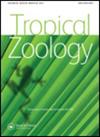Dietary preference and digestive physiology of plankti-benthivorous fishes inhabiting mudflats of Indian Sundarban estuaries
IF 0.7
4区 生物学
Q4 ZOOLOGY
引用次数: 2
Abstract
In this study, the digestive physiology of 12 plankti-benthivorous species as functional analogues from intertidal mudflats of Indian Sundarbans was carried out in order to find out whether diet or phylogeny played a larger role in influencing digestive enzyme activity. Upon analysis of prey preferences, they were categorized into different trophic subgroups. Two dendrograms, one based on prey diversity and other on digestive enzymes of studied fish species were constructed through cluster analysis. These dendrograms were compared again with the phylogenetic tree constructed on the basis of the taxonomic positions. The specific nature of the enzymes in two plankti-detritivorous fishes appeared to possess a specific feeding behaviour and dietary preference though no clear predominance among digestive enzymes was observed. However, regardless of different feeding habits, four gobiid species showed similarity in their overall digestive enzyme patterns and clustered together. Despite mixed results, it can be concluded that digestive enzymes may serve as effective indicators of the feeding ecology of fishes, but the physiological requirements to live in specific trophic guilds may differ among families and therefore, influence of phylogeny on the digestive physiology could not be avoided without understanding the evolutionary specializations for these feeding modes in fishes.栖息在印度孙德班河口泥滩的浮游-底栖鱼类的饮食偏好和消化生理
本研究对来自印度孙德尔本斯潮间带泥滩的12种具有功能类似物的浮游-底栖物种进行了消化生理研究,以确定饮食还是系统发育对消化酶活性的影响更大。根据对猎物偏好的分析,它们被划分为不同的营养亚群。通过聚类分析,分别构建了基于食饵多样性和消化酶的树状图。将这些树状图与根据分类位置构建的系统发育树进行了比较。在两种浮游营养性鱼类中,消化酶的特异性表现为具有特定的摄食行为和饮食偏好,但消化酶之间没有明显的优势。然而,尽管摄食习性不同,四种虾虎鱼的整体消化酶模式都表现出相似性,并聚集在一起。尽管结果好坏不一,但可以得出结论,消化酶可能是鱼类摄食生态的有效指标,但不同科类对特定营养行会的生理需求可能不同,因此,在不了解鱼类这些摄食方式的进化特化的情况下,系统发育对消化生理的影响是不可避免的。
本文章由计算机程序翻译,如有差异,请以英文原文为准。
求助全文
约1分钟内获得全文
求助全文
来源期刊

Tropical Zoology
生物-动物学
CiteScore
2.50
自引率
0.00%
发文量
1
审稿时长
>12 weeks
期刊介绍:
Tropical Zoology is an international zoological journal publishing original papers in the field of systematics, biogeography, phylogeny, ecology and conservation of all terrestrial and aquatic animal Phyla from tropical and subtropical areas.
Only papers with new information, high quality and broad interest are considered. Single species description and checklists are not normally accepted. Review papers are welcome. The journal is owned by the Istituto di Ricerca sugli Ecosistemi Terrestri of the Consiglio Nazionale delle Ricerche, Florence, Italy (CNR-IRET) who performs research into the structure and functioning of aquatic and terrestrial ecosystems, focusing in particular on anthropogenic pressure and global change. The knowledge amassed forms the scientific basis for identifying the most appropriate protective and corrective interventions, and provides support for the bodies entrusted with formulating policies for environmental protection and recovery.
 求助内容:
求助内容: 应助结果提醒方式:
应助结果提醒方式:


